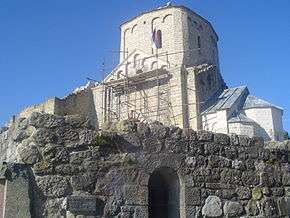Đurđevdan
| Saint George's day | |
|---|---|
|
Icon of Saint George | |
| Date | 6 May |
| Next time | 6 May 2017 |
| Frequency | annual |
Saint George's Day (Serbian: Đurđevdan, Ђурђевдан pronounced [ˈdʑûːrdʑeʋdaːn], Bulgarian Gergyovden, Macedonian Gjurgjuvden, Russian Его́рий Ве́шний Yegoriy Veshniy "George's [day] in spring") is a Slavic religious holiday, the feast of Saint George celebrated on 23 April by the Julian calendar (6 May by the Gregorian calendar). In Croatia and Slovenia, the Roman Catholic version of St. George's day, Jurjevo is celebrated on 23 April by the Gregorian calendar.
Saint George is one of the most important saints in the Eastern Orthodox tradition. He is the patron military saint in Slavic, Georgian and Circassian, Cossack, Chetnik military tradition. Christian synaxaria hold that St. George was a martyr who died for his faith. On icons, he is usually depicted as a man riding a horse and killing a dragon.
Beyond Orthodox Christian tradition proper, Đurđevdan is also more generically a spring festival in the Balkans.
South Slavic tradition

Jurjevo is mainly celebrated in the rural areas of Croatia, mostly Turopolje and Gornja Stubica whereas every Đurđevdan is celebrated all over the Serbian diaspora but mainly in Serbia, Kosovo, Montenegro, Bosnia Herzegovina and Macedonia. In Croatian St. George is called Sv. Juraj while in Serbian he's called Sveti Đorđe (Serbian Cyrillic: Свети Ђорђе), in Bulgarian Sveti Georgi (Cyrillic: Свети Георги) and in Macedonian Sv. Gjorgjija (Ѓорѓија).
In Croatia, the Roman Catholic version of St. George's day, Jurjevo is celebrated on 23 April by the Gregorian calendar. The tradition is mostly celebrated in northern Croatia, in Zagreb County.
Balkanese spring festivals
According to tradition this day marks the beginning of spring. The use of bonfires is similar to Walpurgis Night. In Turopolje Jurjevo involves a Slavic tradition where five most beautiful girls are picked to play as Dodola goddesses dressed in leaves and sing for the village every day till the end of the holiday.
Đurđevdan is also celebrated by the Gorani from the Gora region in southern Kosovo. The Gorani are a Slavic Muslim group, who converted from Orthodox Christianity to Islam during the 18th century but kept a few Serbian – Christian traditions, including Đurđevdan. The holiday has a center in and around the village of Globočica. It's also celebrated by members of the uncanonical Montenegrin Orthodox Church.
Đurđevdan (Romany: Ederlezi) is also a major holiday for Romani from former Yugoslavia, whether Orthodox or Muslim. The various Balkan spellings (Herdeljez, Erdelezi) are variants of the Turkish Hıdırellez.
In Bosnia, the major holidays of all religious groups were celebrated by all other religious groups as well, at least until religion-specific holidays became a marker of ethnic or nationalist self-assertion after the breakup of Yugoslavia. Roman Catholic Christmas, Orthodox Christmas, and the two Muslim Bajrams were widely recognized by people of all ethnic groups, as was Ðurđevdan even though it was properly an Orthodox holiday and therefore associated with Serbs.
The holiday's widespread appeal, beyond the Orthodox Christian groups, in the Balkans, is in evidence in Meša Selimović's novel Death and the Dervish, where the pious Muslim protagonist views it as a dangerous pagan throwback, but where it is clearly celebrated by all ethnic groups in the unnamed city of its setting (widely considered to be Sarajevo).
This holiday celebrates the return of springtime and is considered the most important. The traditions of the Roma Durđevdan are based on decorating the home with flowers and blooming twigs as a welcoming to spring. It also includes taking baths added with flowers and washing hands with water from church wells. Also the walls of the home could be washed with the water. On the day of the feast it is most common to grill a lamb for the feast dinner. The appearance of music is also very important during this holiday. Aside from dancing and singing, traditional brass bands are popular.
"Ðurđevdan" is also the name of a popular song by band Bijelo dugme. The song is originally found on their studio album Ćiribiribela from 1988. It is a cover song (with different lyrics) for a popular traditional folk song of the Romani, "Ederlezi". Which was largely made famous by Goran Bregović.
Eastern Slavic tradition

Yuri's day of spring (Russian: Юрьев день, Егорий Вешний, Yuriev Den, Egoriy Veshniy) is the Russian name for either of the two feasts of Saint George celebrated by the Russian Orthodox Church.
Along with various other Christian churches, the Russian Orthodox Church celebrates the feast of Saint George on April 23 (Julian calendar), which falls on May 6 of the Western (Gregorian calendar. In addition to this, the Russian Church also celebrates the anniversary of the consecration of the Church of St George in Kiev by Yaroslav the Wise (1051) on November 26 (Julian calendar), which currently falls on December 9. One of the Russian forms of the name George being Yuri, the two feasts are popularly known as Vesenniy Yuriev Den (Yuri's Day in the Spring) and Osenniy Yuriev Den (Yuri's Day in the Autumn).
See also
| Wikimedia Commons has media related to Đurđevdan. |
| Wikimedia Commons has media related to Egoriy. |
References
- Alexander Panchenko, Review of the book by Laura Stark, Peasants, Pilgrims, and Sacred Promises: Ritual and Supernatural in Orthodox Karelian Folk Religion
